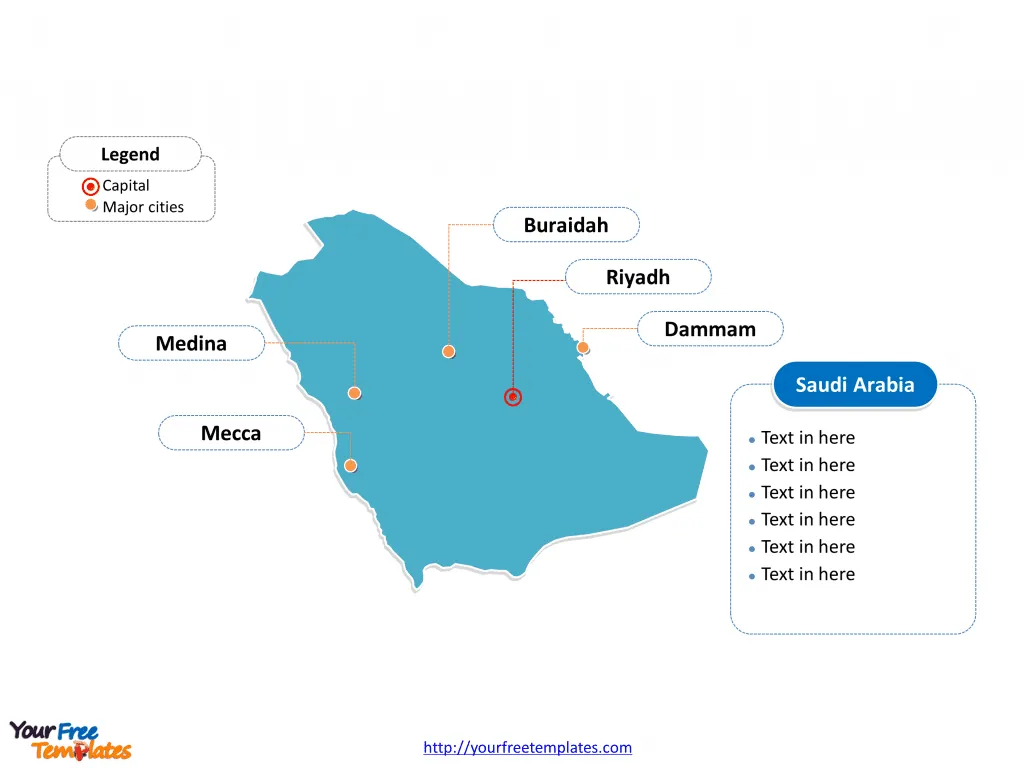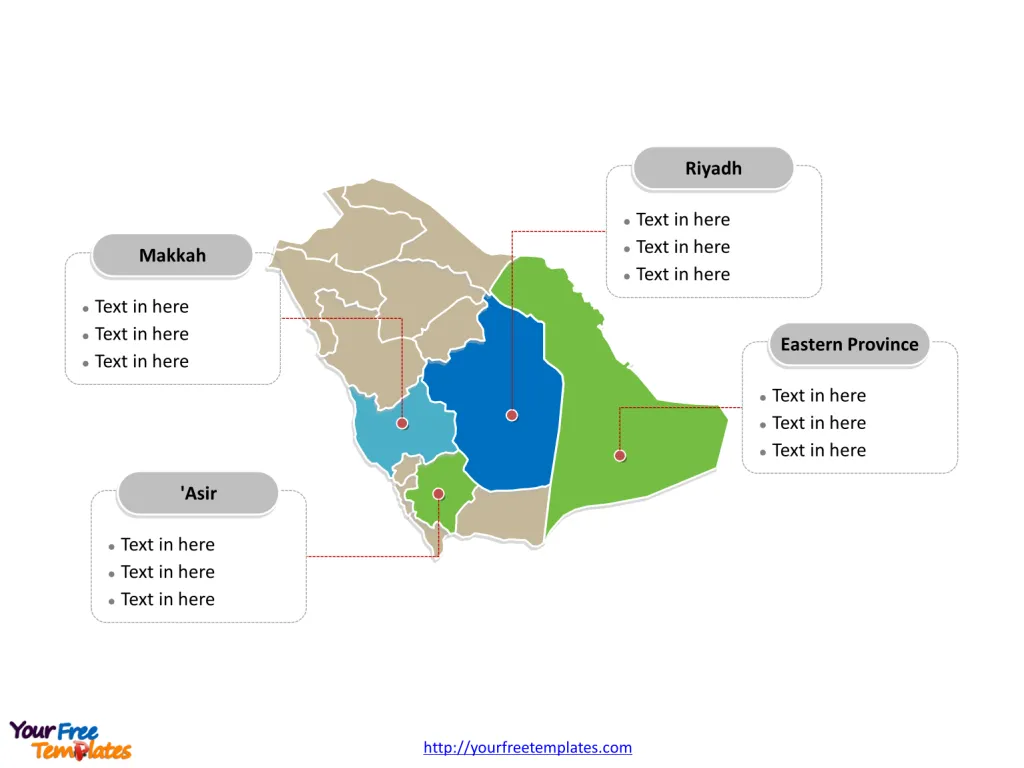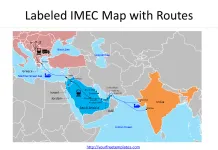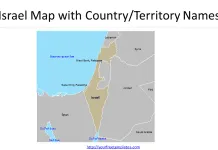The Map of Saudi Arabia Template includes two slides. One is Saudi Arabia map with 13 regions, highlighting main regions, Makkah, Riyadh, Eastern Province, and ‘Asir. The other is Saudi Arabia map labeled with capital and major cities, Riyadh, Mecca, Medina, Dammam, and Buraidah.
Saudi Arabia, officially known as the Kingdom of Saudi Arabia (KSA), is strategically positioned on the Arabian Peninsula in the Middle East. It is the largest country in the Middle East, bordered by Jordan and Iraq to the north, Kuwait to the northeast, Qatar, Bahrain, and the United Arab Emirates to the east, Oman to the southeast, and Yemen to the south. To the west, it has an extensive coastline along the Red Sea, and to the east, a coastline along the Persian Gulf. This geographic positioning places Saudi Arabia at the crossroads of Asia, Africa, and Europe, enhancing its strategic importance globally.
Slide 1, Saudi Arabia map labeled with capital and major cities.
Saudi Arabia, a country known for its vital role in both the Islamic world and the global oil economy, is distinguished by its unique blend of ancient traditions and modern advancements. Its major cities, Riyadh, Mecca, Medina, Dammam, and Buraidah, are central to its cultural, political, and economic life. Additionally, the major regions of Makkah, Riyadh, Eastern Province, and ‘Asir contribute significantly to the country’s diversity and prosperity.
Major Cities on Saudi Arabia map
Riyadh, the capital city, is the heart of Saudi Arabia’s political, economic, and administrative affairs. With a population of over 7.68 million, Riyadh stands as a testament to modernization within a framework of traditional Saudi values. The city is a financial hub, home to the Saudi National Bank, and various other significant institutions. Its King Khalid International Airport and a six-line metro system symbolize Riyadh’s infrastructural advancement.
Mecca is the holiest city in Islam, attracting millions of Muslims annually for the Hajj pilgrimage, an event of profound religious significance. Beyond its spiritual importance, Mecca also has a growing economy centered on accommodating the vast influx of pilgrims, including developments in real estate, hospitality, and services. The city’s economy benefits significantly from the religious tourism that defines it.
Medina is revered as Islam’s second holiest city, housing the Prophet Muhammad’s mosque and grave. Its economy thrives on the pilgrimage and religious tourism sectors, with a significant portion of its population employed in services catering to the millions of pilgrims visiting each year. The city also has a historical inclination towards agriculture, particularly dates.
Dammam, the capital of the Eastern Province, is critical to the nation’s oil industry. Located on the Persian Gulf, it boasts the King Abdul Aziz Sea Port, one of the largest shipping hubs in the region. Dammam forms part of the Dammam Metropolitan Area, which includes Dhahran and Khobar, creating a tri-city area essential for its contribution to the Saudi economy through oil, manufacturing, and shipping.
Buraidah, the capital of Al Qasim Province, is an agricultural heartland known for its vast date palm groves. With a population of 571,169, it is a center for trade within the region, hosting the largest camel market globally. Its economy is diversified with developments in manufacturing and services, reflecting the broader economic goals of Saudi Arabia.

Slide 2, Saudi Arabia map labeled with major Regions.
Saudi Arabia map shows the country divided into 13 regions, ‘Asir, Bahah, Eastern Province, Ha’il, Jawf, Jizan, Madinah, Makkah, Najran, Northern Borders, Qassim, Riyadh, and Tabuk. Every individual political subdivision is an editable shape.
Major Regions on Saudi Arabia map
The Makkah region, with Mecca at its core, is of unparalleled religious importance. However, its significance extends into the economic realm, especially through religious tourism, which stimulates the local economy. The region is also an administrative and educational center, contributing to its multifaceted importance in Saudi Arabia.
The Riyadh region, encompassing the capital city, is the political and economic powerhouse of the country. It is a focal point for banking, manufacturing, and commerce, supported by world-class infrastructure. The region’s development strategy focuses on diversifying its economy beyond oil, evident in the growth of the digital and entertainment sectors.

The Eastern Province is Saudi Arabia’s oil hub, with vast petroleum reserves and the headquarters of Saudi Aramco. Dammam, its capital, plays a crucial role in the oil, gas, and petrochemical industries. The region is pivotal for the country’s economic health, given its contribution to the global energy market.
‘Asir, with Abha as its capital, is known for its mountainous terrain and rich cultural heritage. It has a burgeoning economy based on agriculture, tourism, and small-scale industries. The region’s climate allows for a diverse range of agricultural activities, distinguishing it from the more arid parts of Saudi Arabia
In conclusion, Saudi Arabia’s major cities and regions reflect a blend of ancient heritage and modern dynamism. From the spiritual significance of Mecca and Medina to the economic vigor of Riyadh and Dammam, and the agricultural richness of Buraidah and ‘Asir, the country showcases a diverse and multifaceted identity. As it continues to diversify its economy and embrace modernization, Saudi Arabia remains deeply rooted in the traditions that define its national character.
Find out more about Saudi Arabia in Simple Wiki.
Size: 101K
Type: PPTX
Aspect Ratio: Standard 4:3
Click the blue button to download it.
Download the 4:3 Template
Aspect Ratio: Widescreen 16:9
Click the green button to download it.
Download the 16:9 Template














